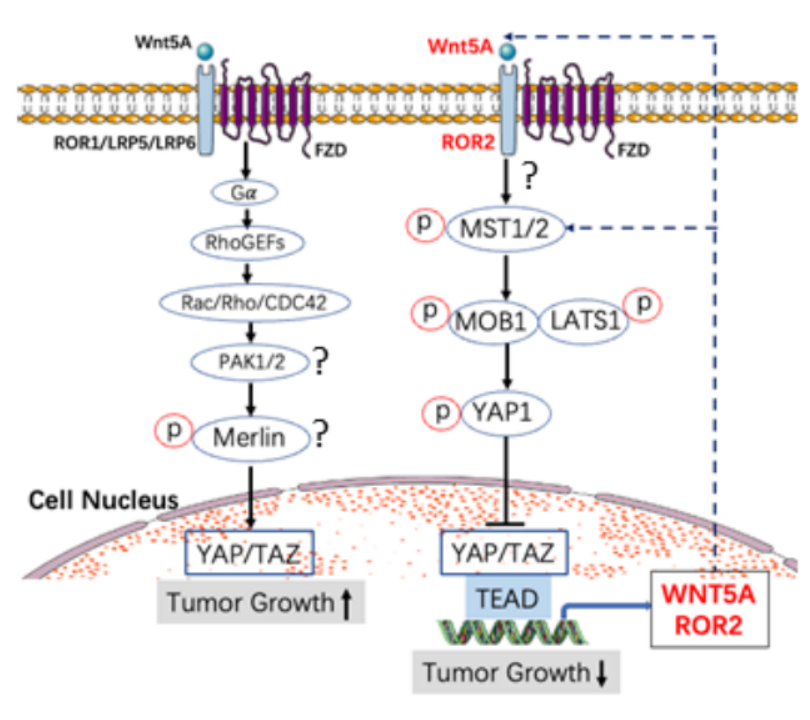更新于:2024-11-01
STRIP2
更新于:2024-11-01
基本信息
别名 FAM40B、FAR11B、KIAA1170 + [4] |
简介 Plays a role in the regulation of cell morphology and cytoskeletal organization. Required in the control of cell shape. |
关联
100 项与 STRIP2 相关的临床结果
登录后查看更多信息
100 项与 STRIP2 相关的转化医学
登录后查看更多信息
0 项与 STRIP2 相关的专利(医药)
登录后查看更多信息
19
项与 STRIP2 相关的文献(医药)2024-09-01·Genomics
STRIP2 is regulated by the transcription factor Sp1 and promotes lung adenocarcinoma progression via activating the PI3K/AKT/mTOR/MYC signaling pathway
Article
作者: Zhang, Jing ; Xiao, Weijin ; He, Liu ; Pan, Junfan ; Xu, Yiquan ; Wu, Yue ; Zhang, Yuan
2023-08-30·Chinese journal of cancer research = Chung-kuo yen cheng yen chiu
Striatins and STRIPAK complex partners in clinical outcomes of patients with breast cancer and responses to drug treatment.
Article
作者: Jiang, Wen G ; Martin, Tracey A ; Sanders, Andrew J ; Li, Amber Xinyu ; Dou, Q Ping ; Ruge, Fiona ; Ye, Lin ; Khan, Elyas ; Zeng, Jimmy Jianyuan ; Davies, Eleri
2023-07-01·Placenta
Associations of prenatal exposure to NO2 and near roadway residence with placental gene expression
Article
作者: Sathyanarayana, Sheela ; Tylavsky, Frances ; Paquette, Alison G ; Hussey, Michael R ; Loftus, Christine T ; Bammler, Theo K ; Szpiro, Adam A ; Zhao, Qi ; Karr, Catherine J ; Marsit, Carmen J ; Bush, Nicole R ; MacDonald, James W ; LeWinn, Kaja Z ; Kaufman, Joel D ; Enquobahrie, Daniel A
2
项与 STRIP2 相关的新闻(医药)2023-06-28
·生物谷
本文中,小编整理了近年来科学家在癌症生物标志物研究领域发表的重要研究成果,分享给大家!
本文中,小编整理了近年来科学家在癌症生物标志物研究领域发表的重要研究成果,分享给大家!
【1】Cancer Res: ROR2可能为前列腺癌潜在的生物标志物
doi:10.1158/0008-5472.CAN-22-3003
前列腺癌症(PCa)是男性癌症相关死亡的主要原因。雄激素剥夺治疗(ADT)仍然是标准的全身治疗,但患者总是进展为转移性去势耐受性前列腺癌症(mCRPC)。这些肿瘤大多会对雄激素信号抑制剂(ASIs)的进一步治疗产生反应,但不可避免地会产生耐药性。雄激素受体(AR)和相互作用途径的改变在许多情况下有助于AR的持续活性和肿瘤生长,而其他肿瘤则独立于AR,其中一部分肿瘤具有神经内分泌特征(神经内分泌前列腺癌,NEPC)。Wnt信号的增加是与mCRPC和ASI抵抗进展相关的机制之一。
近日,来自哈佛医学院医学与癌症中心医学部血液肿瘤科的研究者们在Cancer Research杂志上发表了题为“WNT5a Signaling through ROR2 Activates the Hippo Pathway to Suppress YAP1 Activity and Tumor Growth”的文章,研究结果表明:通过ROR2的WNT5a信号传导激活Hippo通路,以下调YAP1/TAZ活性并抑制肿瘤生长,将ROR2确定为潜在的生物标志物,以识别可能受益于WNT5a相关药物的患者。WNT5a的非规范Wnt信号传导具有致癌和肿瘤抑制活性,但介导这些特定效应的下游途径仍有待完全建立。在前列腺癌症器官样培养和异种移植模型的一个子集中,Wnt合成的抑制刺激生长,而WNT5a或WNT5a-模拟肽(Foxy5)显著抑制肿瘤生长。
WNT5a/FZD介导的对Hippo的抑制与WNT5a/ROR2介导的Hippo激活的模型。
图片来源:https://pubmed-ncbi-nlm-nih-gov.libproxy1.nus.edu.sg/36622276/
WNT5a导致YAP1活性的ROR2依赖性降低,这与MST1/2、LATS1、MOB1和YAP1的磷酸化增加相关,表明Hippo通路激活。删除MST1/2取消了WNT5a响应。WNT5a类似地激活表达ROR2的黑色素瘤细胞中的Hippo,而在ROR2阴性细胞中的WNT5a抑制Hippo。这种抑制与在表达ROR2的细胞中未观察到的NF2/Merlin的抑制性磷酸化增加有关。
【2】Sci Adv:新型生物标志物或能帮助识别出人群胰腺癌的早期风险
doi:10.1126/sciadv.ade4582
管内乳头状粘液瘤(IPMN,intraductal papillary mucinous neoplasms)的组织病理学异质性往往使得科学家们预测机体患胰腺导管腺癌(PDAC)的风险变得非常复杂。近日,一篇发表在国际杂志Science Advances上题为“Digital Spatial Profiling of Intraductal Papillary Mucinous Neoplasms: Towards a Molecular Framework for Risk Stratification”的研究报告中,来自美国杜克大学等机构的科学家们通过研究识别出了一组生物标志物,其或能帮助区分胰腺上的囊肿是否可能会进展为癌症或依然保持良性。
这项研究标志着科学家们向开发临床方法又迈出了重要的一步,该方法或能帮助对胰腺上具有最高致癌风险的病变进行分类,并在其发生扩散之前还能帮助研究人员有效对病变部位进行移除。如果成功的话,这种基于生物标志物的方法或许就能解决降低机体患胰腺癌几率所面临的最大障碍,因为如今人类胰腺癌的发病率不断攀升,而且在机体腹部扫描时往往被偶然间发现时癌变部位就已经悄悄长大了。
医学博士Peter Allen说道,即使胰腺癌在最早期阶段被发现,其几乎都总是在整个机体会脱落细胞,从而促使癌症复发。这就是为何研究人员将目光重点集中在癌变前的囊肿上的原因,即管内乳头状粘液瘤,大部分的管内乳头状粘液瘤永远不会进展为胰腺癌,但通过识别出哪些会发生进展,研究人员或许就能制造机会来预防不治之症的发展;文章中,研究人员利用一种名为数字空间RNA图谱分析的复杂分子生物学工具对囊肿中异常细胞生长的高级别和低级别区域进行定位分析。
【3】Oncotarget:科学家利用代谢组学来揭示人类肝细胞癌的潜在生物标志物
doi:10.18632/oncotarget.28306
代谢组学的定义是对一个生物样本中的所有小分子代谢产物进行全面地识别,其能帮助阐明与多种人类疾病相关的表型变化,包括癌症等。近日,一篇发表在国际杂志Oncotarget上题为“Essential amino acids as diagnostic biomarkers of hepatocellular carcinoma based on metabolic analysis”的研究报告中,来自日本庆应义塾大学等机构的科学家们通过研究利用代谢组学发现了指示肝细胞癌(HCC,hepatocellular carcinoma)的潜在生物标志物。
文章中,研究人员利用毛细管电泳-时间飞行质谱技术对20名原发性肝细胞癌患者进行分析,调查了其机体肿瘤和非肿瘤组织的代谢组学特征,同时还分析了其在肝切除术前和术后14天的血液样本,旨在识别出血清中代谢组的相关变化特征。研究者解释道,当前研究中,我们通过阐明原发性肝细胞癌肿瘤组织和非肿瘤组织的代谢变化情况,以及调查根治性肝切除术前和术后患者机体血清中的代谢组学特征,试图发现诊断肝细胞癌的代谢组学生物标志物。
随后研究人员在61种不同数量的代谢产物中检测到了显著性的改变,其或呢过帮助区分原发性肝癌肿瘤和配对的非肿瘤组织,以及原发性肝癌肿瘤和结直肠肝脏转移,相比非肿瘤组织而言,肝细胞癌肿瘤中有30种代谢产物会明显上调,其中有10种是氨基酸,7种是必需氨基酸,包括亮氨酸、缬氨酸、色氨酸、异亮氨酸、蛋氨酸、赖氨酸和苯丙氨酸等。同样地,患者在进行肝切除术术前血清中的代谢组能揭示16种代谢产物的明显增加,包括亮氨酸、缬氨酸和色氨酸;本文研究结果揭示了与非肿瘤组织相比而言肝细胞癌肿瘤中代谢组学的显著差异,并识别出了包括亮氨酸、缬氨酸和色氨酸作为肝细胞癌的潜在代谢生物标志物。
【4】JECCR:科学家发现了一种潜在的非小细胞肺癌预后生物标志物和治疗靶点
doi:10.1186/s13046-022-02573-1
肺癌是全球最常见的恶性肿瘤,也是癌症相关死亡的主要原因。它主要包括非小细胞肺癌(NSCLC)和小细胞肺癌(SCLC)。非小细胞肺癌占所有肺癌患者的75%-85%。约40-60%的患者在确诊时已是晚期和转移性疾病。然而,手术切除一般不适合晚期患者。推荐的治疗策略是综合全身治疗(例如,化疗、放射治疗、分子靶向治疗或免疫治疗)。但由于远处转移,晚期患者的五年生存率仅为5%。以往的研究表明,非小细胞肺癌最常见的转移部位是肺、骨、脑和肝脏。因此,制定合理的术后随访计划,采取有针对性的干预措施,筛选转移相关蛋白,研究非小细胞肺癌的转移机制,有助于制定合理的术后随访计划和采取针对性的干预措施。
STRIP2促进非小细胞肺癌肿瘤进展的分子机制。
图片来源: https://doi-org.libproxy1.nus.edu.sg/10.1186/s13046-022-02573-1
近日,来自湖州大学第一附属医院的研究者们在J Exp Clin Cancer Res杂志上发表了题为“STRIP2 motivates non-small cell lung cancer progression by modulating the TMBIM6 stability through IGF2BP3 dependent”的文章,该研究结果表明,STRIP2与IGF2BP3相互作用,以m6A依赖的方式调节TMBIM6mRNA的稳定性,可能是一种潜在的NSCLC预后生物标志物和治疗靶点。Striatin Interaction Protein 2(STRIP2)是STRIPAK复合体的核心成分,通过调节细胞收缩和转移参与肿瘤的发生和发展。然而,STRIP2在非小细胞肺癌(NSCLC)进展中的潜在分子机制在很大程度上仍不清楚。
研究者采用定量RT-PCR、Western blotting和免疫组织化学(IHC)方法检测STRIP2和IGF2BP3在人NSCLC标本和NSCLC细胞系中的表达。在体内外研究了STRIP2在促进NSCLC进展中的作用及其分子机制。在本研究中,研究者发现STRIP2在非小细胞肺癌组织中的表达显著升高,并且高表达与预后不良相关。STRIP2基因的敲除在体内外均能抑制肿瘤的生长和转移,而过表达的STRIP2则起到相反的作用。
【5】Sci Adv:新型基于人工智能的生物标志物或能帮助预测非小细胞肺癌患者的免疫疗法治疗反应
doi:10.1126/sciadv.abq4609
肿瘤血管是影响肿瘤行为和治疗耐受性的肿瘤微环境中的关键组分,近日,一篇发表在国际杂志Science Advances上题为“A tumor vasculature–based imaging biomarker for predicting response and survival in patients with lung cancer treated with checkpoint inhibitors”的研究报告中,来自凯斯西储大学等机构的科学家们通过进行一项回顾性研究发现,一种新型的人工智能衍生的生物标志物或能利用常规的成像扫描来预测哪些肺癌患者会对免疫疗法产生反应,相关研究结果不仅能为患者和临床医生制定疗法决策提供指导,还能帮助减少与免疫疗法相关的经济负担。
研究者Mohammadhadi Khorrami博士表示,仅仅通过基线CT扫描来预测机体对免疫疗法反应的能力或许会改变游戏规则,因为如果我们发现哪些患者对疗法产生或不产生反应,我们都能提供不同的治疗模式;此外,由于免疫疗法的治疗费用惊人(每名患者每年大约需要20万美元),因此在开始治疗之前非侵入性地确定这种反应的需要就变得非常重要了。
名为“定量血管弯曲”(QVT,quantitative vessel tortuosity)的新型生物标志物能分析肿瘤周围血管的特点,从而影响肿瘤的行为和疗法耐受性,肿瘤会适合机体建立新血管的机制并将尽可能多的血液重新导向肿瘤以便其能快速生长并扩散到机体全身,相比正常的血管而言,肿瘤相关的血管是混乱排列和扭曲的。研究者Khorrami及其同事利用AI工具评估了500多名非小细胞肺癌患者在免疫检查点阻滞疗法进行之前和之后机体中QVT生物标志物的不同方面,结果发现,对免疫检查点阻滞疗法没有反应的患者机体的血管要比产生反应的患者的血管更加扭曲,于是他们假设,血管扭曲会导致抗肿瘤细胞在肿瘤位点部位聚集,但并不能有效浸润肿瘤从而削弱免疫疗法的治疗效果。
【6】Europ Urol:科学家发现机体骨质生物标志物和前列腺癌患者的存活率之间存在强相关性
doi:10.1016/j.eururo.2023.03.036
前列腺癌是引发美国男性死亡的第二大主要原因,理解影响患者预后的因素对于改善治疗前列腺癌的疗法以及患者的存活率至关重要。近日,一篇发表在国际杂志European Urology上题为“Bone Biomarkers and Subsequent Survival in Men with Hormone-sensitive Prostate Cancer: Results from the SWOG S1216 Phase 3 Trial of Androgen Deprivation Therapy with or Without Orteronel”的研究报告中,来自加州大学戴维斯分校综合癌症中心等机构的科学家们通过研究揭示新诊断的激素敏感性前列腺癌(HSPC,hormone-sensitive prostate cancer)患者在接受去势治疗(ADT,androgen deprivation therapy)后,其机体中骨代谢生物标志物和其生存率之间的关联。
文章中,研究人员分析了来自SWOG癌症研究网络3期临床试验中近1000名接受ADT的患者的研究结果,包括同时接受新型激素疗法Orteronel的患者,参与临床试验的患者来自全国248个学术和社区中心,在参加试验的HSPC患者中,研究人员对其机体骨质流失和骨形成的骨生物标志物进行了相关研究。
研究人员发现,骨生物标志物水平的升高或与患者死亡风险增加有关,骨生物标志物被发现会影响去势难治性前列腺癌(CRPC,castration-resistant prostate cancer)患者的总体生存率,CRPC是一种即时机体高通水平明显降低的情况下仍然会继续生长的前列腺癌类型。研究者表示,本文研究结果表明,高水平的骨生物标志物或与新诊断为转移性HSPC的男性寿命较短有关;未来,知晓个体机体的骨生物标志物状态或许就能改善科学家们预测患者的治疗结局并增强HSPC男性对疗法的考虑。
在晚期前列腺癌患者中,重建骨骼细胞和破坏骨骼的细胞之间的精细化平衡相互作用非常常见,这些男性经常会发生前列腺癌骨转移,而这是骨痛和患者骨折的常见来源,其会影响患者的生存。此外,患有转移性HSPC的男性通常会接受ADT的治疗,ADT会扰乱机体的骨骼更替并继续促进诸如骨量减少和骨质疏松症等骨骼疾病的发生;此前研究结果表明,基于血液的骨质更新生物标志物水平的升高或能帮助预测CRPC男性的生存率,而骨质靶向性疗法或能帮助治疗标志物水平高度升高的患者。
【7】ACS Chem Neurosci:新型生物标志物或能帮助科学家们尽可能早地诊断阿尔兹海默病
doi:10.1021/acschemneuro.2c00342
曾经,科学家们对阿尔兹海默病的明确诊断只有在患者死亡后才有可能,但最近的生物标志物研究或有望帮助研究人员开发新型的成像和脊髓液测试技术来对活着的疑似患者进行研究,然而,这些测试仅仅能监测严重的疾病,并能将晚期的阿尔兹海默病与相关疾病区分开来;近日,一篇发表在国际杂志ACS Chemical Neuroscience上题为“Site-Specific Phospho-Tau Aggregation-Based Biomarker Discovery for AD Diagnosis and Differentiation”的研究报告中,来自北卡罗来纳州中央大学等机构的科学家们通过研究识别出了一种新型的生物标志物,其或能帮助临床医生更早地诊断阿尔兹海默病,这时候患者或许已经过渡到了轻度的认知损伤阶段(MCI)了。
新型生物标志物或能帮助科学家们尽可能早地诊断阿尔兹海默病。
图片来源:ACS Chemical Neuroscience (2022). DOI:10.1021/acschemneuro.2c00342
在寻找阿尔兹海默病生物标志物时,一些研究人员转向研究名为tau蛋白的细微改变,这些变化或翻译后修饰或许能使得tau蛋白更有可能发生结块,从而就会导致神经元丧失以及记忆损伤;诸如这两种修饰主要涉及tau蛋白在特定氨基酸位点处的磷酸化修饰,从而就会导致产生p-tau181和p-tau217两个版本,这些生物标志物也被证明能有效区分阿尔兹海默病组织以及其它神经退行性疾病患者机体的组织。
由于在医生的“工具箱”中拥有多种生物标志物是非常有帮助的,因此,研究者Bin Xu等人就开始寻找额外的p-tau蛋白生物标志物来对阿尔兹海默病进行有效地诊断,或者尽可能早地捕捉这种疾病。利用来自阿尔兹海默病患者和非阿尔兹海默病受试者死亡后的大脑组织进行研究,研究人员识别出了多个p-tau生物标志物或与tau聚集存在选择性相关性,与p-tau181和p-tau217一样,其中多个生物标志物都能帮助有效区分阿尔兹海默病患者的组织和健康个体的组织,尤其是其中名为p-tau198的标志物还能将阿尔兹海默病与其它两种已知的tau聚集的神经退行性疾病区分开。
【8】Sci Transl Med:科学家识别出能帮助预测黑色素瘤患者对免疫疗法耐受的特殊生物标志物
doi:10.1126/scitranslmed.abq7019
肿瘤所固有的NOD-、LRR-和包含pyrin结构域蛋白-3(NLRP-3)炎性小体热激蛋白70(HSP70)信号轴能通过CD8+ T细胞细胞毒性所诱发,并通过将粒细胞多形核髓源性抑制细胞(PMN-MDSCs)招募到肿瘤微环境中,从而促进对抗程序性细胞死亡蛋白1(PD-1)免疫疗法适应性耐受性的发展。近日,一篇发表在国际杂志Science Translational Medicine上题为“Tumor-intrinsic NLRP3-HSP70-TLR4 Axis Drives Pre-Metastatic Niche Development and Hyperprogression During Anti-PD-1 Immunotherapy”的研究报告中,来自杜克大学癌症研究所等机构的科学家们通过研究识别出了一种潜在的生物标志物,其或能帮助预测检查点一制剂药物产生事与愿违效果的可能性,并能帮助驱动黑色素瘤细胞的超级进展,而并不是释放免疫系统来抵御癌细胞。
此前研究结果表明,在摄入检查点抑制剂时出现超级进展的癌症患者的平均总生存时间(median overall survival)为4.6个月,而没有并发症的患者的平均总生存时间则为7.6个月,这种现象如今在多种类型的肿瘤中已经被证明,其并不是仅仅是黑色素瘤,而是头颈癌、肺癌和乳腺癌等。这项在小鼠和人类组织中进行的最新研究针对的是一种能抑制超级进展的策略,其或许能潜在让10%的患者从检查点抑制剂免疫疗法中获益。
科学家识别出能帮助预测黑色素瘤患者对免疫疗法耐受的特殊生物标志物。
图片来源:Science Translational Medicine (2022). DOI:10.1126/scitranslmed.abq7019
医学博士Brent Hanks说道,在对免疫疗法耐受性和超级进展状态的发生之间或许存在一种连续的关系,尽管超级进展会在接受检查点抑制剂疗法的一小部分癌症患者中发生,但识别出这种现象的可能性或许能潜在改变临床疗法并避免并发症的发生。检查点抑制剂是一种癌症得以成功治疗的案例,但超级进展在某些患者机体中却会诱发很麻烦的副作用,于是研究者Hanks等人就开始调查黑色素瘤中这一过程背后的分子机制,从而就识别出了一种特殊的蛋白复合体,其是一种称之为NLRP3炎性小体的复合体,植根于癌症肿瘤中。
【9】JID:科学家开发出有望识别黑色素瘤特殊生物标志物的新型分析技术
doi:10.1016/j.jid.2021.06.041
黑色素瘤的早期诊断对于改善患者的生存率至关重要,然而,早期黑色素瘤进化的生物标志物以及在肿瘤和微环境中的起源(包括角化细胞),目前研究人员并不清楚。近日,一篇发表在国际杂志Journal of Investigative Dermatology上题为“High-Plex Spatial RNA Profiling Reveals Cell Type-Specific Biomarker Expression during Melanoma Development”的研究报告中,来自加利福尼亚大学等机构的科学家们通过研究发现了黑色素瘤细胞类型特异性的生物标志物。
黑色素瘤是一种最常见的致死性皮肤癌,通过早期诊断和治疗,患者常常能被治愈。然而,在临床中及在显微镜下诊断黑色素瘤可能会因为所谓的黑色素细胞痣(也就是所谓的胎记或非癌性痣)而变得较为复杂,黑色素瘤的发展是一个多步骤过程,其中皮肤上的黑色素瘤细胞中常常含有黑色素,其会发生突变和增殖,在早期阶段正确识别黑色素瘤对于改善患者的生存率至关重要。
研究者Maija Kiuru说道,早期黑色素瘤进化的生物标志物以及肿瘤和微环境中黑色素瘤的起源对于尽可能早地诊断黑色素瘤非常重要,为了揭开这一谜题,我们利用多路空间RNA分析技术来捕捉黑色素瘤发生过程中多种细胞类型的基因表达模式,这种方法或能帮助研究人员对数百种甚至数千种基因的表达进行研究,同时还不会破坏肿瘤的原始结构。研究人员对富含黑色素细胞的134个感兴趣的区域以及邻近的角化细胞或免疫细胞中超过1000个基因的表达进行了分析,黑色素细胞是皮肤和眼睛中能产生黑色素的特殊细胞,所检查的组织来自于12种肿瘤的患者活组织样本,其从良性到恶性不等,研究人员使用NanoString GeoMx数字空间分析技术进行研究。
【10】Cancer Res:科学家识别出基于肿瘤的甲基化模式或许能作为特殊的癌症生物标志物
doi:10.1158/0008-5472.CAN-21-3113
在癌症治疗过程中,生物标志物通常能被用来指导疗法的决策和预测患者的治疗结局,然而,研究人员通常很难识别出适当的生物标志物,这些标志物能够持续复制并且很容易利用有限的患者样本来进行分析,近日,一篇发表在国际杂志Cancer Research上题为“Tumor Expression Quantitative Trait Methylation Screening Reveals Distinct CpG Panels for Deconvolving Cancer Immune Signatures”的研究报告中,来自Moffitt癌症研究中心等机构的科学家们通过研究根据一种被称为甲基化的遗传修饰来识别出特殊的生物标志物,其或能用来预测肿瘤免疫环境的类型和患者的治疗结局。
原始出处:https://aacrjournals-org.libproxy1.nus.edu.sg/cancerres/article-abstract/82/9/1724/694708/Tumor-Expression-Quantitative-Trait-Methylation?redirectedFrom=fulltext
基因往往会受到特定修饰的高度调节,这些修饰要么会促进或阻断基因的表达,一种类型的表观遗传学修饰称之为甲基化,其主要包括将甲基化基团添加到基因的特定区域,通常情况下,基因启动子区域高水平的甲基化往往与较低水平的基因表达有关,最近,有研究表明,基因甲基化的模式或许是一种潜在的生物标志物,利用甲基化作为生物标志物相比利用基因表达生物标志物而言往往拥有多个优势,包括可重复性和稳定性,这些特性或许就使其更易于在临床上使用,不同的测试技术之间的差异较小,以及能利用冷冻或固定在甲醛中并嵌入到石蜡中的组织标本。
目前,细胞溶解活性评分是一种成熟的生物标志物,其能基于基因表达来预测肿瘤浸润性淋巴细胞的存在,肿瘤浸润性淋巴细胞是一类能从血液中移出并进入肿瘤的特殊免疫细胞,肿瘤中高水平的肿瘤浸润性淋巴细胞或与患者预后改善直接相关,细胞溶解活性评分或能通过测定基因表达的模式来预测肿瘤浸润性淋巴细胞的存在,尤其是细胞毒性T细胞。这项研究中,研究人员想通过研究识别出那些比常用的生物标志物更好的生物标志物,比如细胞溶解活性评分(用于识别冷/热肿瘤),研究人员提出了基于肿瘤的表达定量形状甲基化的概念,即将基因甲基化模式与基因表达相关联来识别出潜在的生物标志物。研究人员专注于将黑色素瘤作为一种疾病模型,并评估是否其能识别出特定的甲基化特征,从而帮助预测肿瘤的免疫环境是什么样子以及患者的治疗结局。(生物谷Bioon.com)
生物谷更多精彩盘点!敬请期待!

临床结果抗体药物偶联物
2023-02-21
·生物谷
肺癌是全球最常见的恶性肿瘤,也是癌症相关死亡的主要原因。它主要包括非小细胞肺癌(NSCLC)和小细胞肺癌(SCLC)。非小细胞肺癌占所有肺癌患者的75%-85%。
肺癌是全球最常见的恶性肿瘤,也是癌症相关死亡的主要原因。它主要包括非小细胞肺癌(NSCLC)和小细胞肺癌(SCLC)。非小细胞肺癌占所有肺癌患者的75%-85%。约40-60%的患者在确诊时已是晚期和转移性疾病。
然而,手术切除一般不适合晚期患者。推荐的治疗策略是综合全身治疗(例如,化疗、放射治疗、分子靶向治疗或免疫治疗)。但由于远处转移,晚期患者的五年生存率仅为5%。以往的研究表明,非小细胞肺癌最常见的转移部位是肺、骨、脑和肝脏。
因此,制定合理的术后随访计划,采取有针对性的干预措施,筛选转移相关蛋白,研究非小细胞肺癌的转移机制,有助于制定合理的术后随访计划和采取针对性的干预措施。
图片来源: https://doi-org.libproxy1.nus.edu.sg/10.1186/s13046-022-02573-1
近日,来自湖州大学第一附属医院的研究者们在J Exp Clin Cancer Res杂志上发表了题为“STRIP2 motivates non-small cell lung cancer progression by modulating the TMBIM6 stability
through IGF2BP3 dependent”的文章,该研究结果表明,STRIP2与IGF2BP3相互作用,以m6A依赖的方式调节TMBIM6mRNA的稳定性,可能是一种潜在的NSCLC预后生物标志物和治疗靶点。
Striatin Interaction Protein 2(STRIP2)是STRIPAK复合体的核心成分,通过调节细胞收缩和转移参与肿瘤的发生和发展。然而,STRIP2在非小细胞肺癌(NSCLC)进展中的潜在分子机制在很大程度上仍不清楚。
研究者采用定量RT-PCR、Western blotting和免疫组织化学(IHC)方法检测STRIP2和IGF2BP3在人NSCLC标本和NSCLC细胞系中的表达。在体内外研究了STRIP2在促进NSCLC进展中的作用及其分子机制。
在本研究中,研究者发现STRIP2在非小细胞肺癌组织中的表达显著升高,并且高表达与预后不良相关。STRIP2基因的敲除在体内外均能抑制肿瘤的生长和转移,而过表达的STRIP2则起到相反的作用。
机制上,P300/CBP介导的STRIP2启动子H3K27乙酰化激活可诱导STRIP2转录,并与胰岛素样生长因子2mRNA结合蛋白3(IGF2BP3)相互作用,上调IGF2BP3转录。此外,STRIP2IGF2BP3轴刺激TMBIM6mRNA的m6A修饰,增强TMBIM6的稳定性。
因此,TMBIM6依赖于STRIP2和IGF2BP3参与NSCLC细胞的增殖、迁移和侵袭。在NSCLC患者中,STRIP2、IGF2BP3和TMBIM6的高共表达与不良预后相关。
STRIP2促进非小细胞肺癌肿瘤进展的分子机制
图片来源: https://doi-org.libproxy1.nus.edu.sg/10.1186/s13046-022-02573-1
总体而言,本研究表明,STRIP2是一种癌基因,以m6A依赖的方式介导非小细胞肺癌TMBIM6水平的稳定。(生物谷 Bioon.com)
参考文献
Xilin Zhang et al. STRIP2 motivates non-small cell lung cancer progression by modulating the TMBIM6 stability through IGF2BP3 dependent. J Exp Clin Cancer Res. 2023 Jan 13;42(1):19. doi: 10.1186/s13046-022-02573-1.

临床结果
分析
对领域进行一次全面的分析。
登录
或

标准版
¥16800
元/账号/年
新药情报库 | 省钱又好用!
立即使用
来和芽仔聊天吧
立即开始免费试用!
智慧芽新药情报库是智慧芽专为生命科学人士构建的基于AI的创新药情报平台,助您全方位提升您的研发与决策效率。
立即开始数据试用!
智慧芽新药库数据也通过智慧芽数据服务平台,以API或者数据包形式对外开放,助您更加充分利用智慧芽新药情报信息。
生物序列数据库
生物药研发创新
免费使用
化学结构数据库
小分子化药研发创新
免费使用